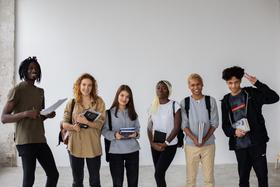Top Rankings
KIPP DC PCS School District ranks among the top 20% of public school district in District Of Columbia for:
Category
Attribute
Graduation Rate
Highest graduation rate (Top 20%)
Community Size
Largest student body (number of students) (Top 1%)
For the 2025 school year, there are 2 public high schools serving 1,191 students in KIPP DC PCS School District. This district's average high testing ranking is 3/10, which is in the bottom 50% of public high schools in District Of Columbia.
Public High Schools in KIPP DC PCS School District have an average math proficiency score of 4% (versus the District Of Columbia public high school average of 15%), and reading proficiency score of 22% (versus the 35% statewide average).
Public High School in KIPP DC PCS School District have a Graduation Rate of 88%, which is more than the District Of Columbia average of 76%.
The school with highest graduation rate is Kipp Dc Pcs - Legacy College Preparatory Pcs, with ≥90% graduation rate. Read more about public school graduation rate statistics in District Of Columbia or national school graduation rate statistics.
Minority enrollment is 100% of the student body (majority Black), which is more than the District Of Columbia public high school average of 91% (majority Black).
Overview
This School District
This State (DC)
# Schools
20 Schools
47 Schools
# Students
7,323 Students
24,328 Students
# Teachers
582 Teachers
2,163 Teachers
Student : Teacher Ratio
13:1
13:1
Student By Grade
District Rank
KIPP DC PCS School District, which is ranked within the bottom 50% of all 57 school districts in District Of Columbia (based off of combined math and reading proficiency testing data) for the 2022-2023 school year.
The school district's graduation rate of 87% has increased from 80-84% over five school years.
Overall District Rank
#27 out of 57 school districts
(Top 50%)
(Top 50%)
Math Test Scores (% Proficient)
13%
22%
Reading/Language Arts Test Scores (% Proficient)
19%
31%
Science Test Scores (% Proficient)
2%
10%
Graduation Rate
87%
76%
Students by Ethnicity:
Diversity Score
0.06
0.53
% American Indian
n/a
n/a
% Asian
n/a
1%
% Hispanic
2%
22%
% Black
97%
65%
% White
1%
9%
% Hawaiian
n/a
n/a
% Two or more races
n/a
3%
All Ethnic Groups
District Revenue and Spending
The revenue/student of $29,061 in this school district is less than the state median of $31,299. The school district revenue/student has stayed relatively flat over four school years.
The school district's spending/student of $34,523 is higher than the state median of $31,192. The school district spending/student has stayed relatively flat over four school years.
Total Revenue
$213 MM
$2,882 MM
Spending
$253 MM
$2,873 MM
Revenue / Student
$29,061
$31,299
Spending / Student
$34,523
$31,192
Best KIPP DC PCS School District Public High Schools (2025)
School
(Math and Reading Proficiency)
(Math and Reading Proficiency)
Location
Grades
Students
Rank: #11.
Kipp Dc - College Preparatory Pcs
Charter School
(Math: 4% | Reading: 24%)
Rank:
Rank:
3/
Bottom 50%10
1405 Brentwood Parkway Ne
Washington, DC 20002
(202) 678-2527
Washington, DC 20002
(202) 678-2527
Grades: 9-12
| 696 students
Rank: #22.
Kipp Dc Pcs - Legacy College Preparatory Pcs
Charter School
(Math: 3% | Reading: 15-19%)
Rank:
Rank:
2/
Bottom 50%10
3999 8th Street Se
Washington, DC 20032
(202) 562-9170
Washington, DC 20032
(202) 562-9170
Grades: 9-12
| 495 students
Recent Articles

Opinion: Handcuffing in Public Schools is a Gateway to More Violence
Some districts are banning handcuffing, while others are cuffing kindergarteners simply throwing a temper tantrum. Read this editorial to see why this author believes slapping the cuffs on children鈥檚 wrists only leads to more behavior issues and violence in their adult lives.

Whooping Cough: Should Vaccinations be Required for Public School Enrollment?
Whopping cough is making a comeback, especially amongst children, prompting health officials to encourage pertussis vaccines and boosters. However, should the pertussis vaccine be required for public school enrollment? Learn about current proposed laws and its ramifications.

What are Common Core Standards and Why Do We Need Them?
With schools nationwide adopting common core standards, we鈥檒l take a look at what they are, their benefits, and how they will change the face of public education.





